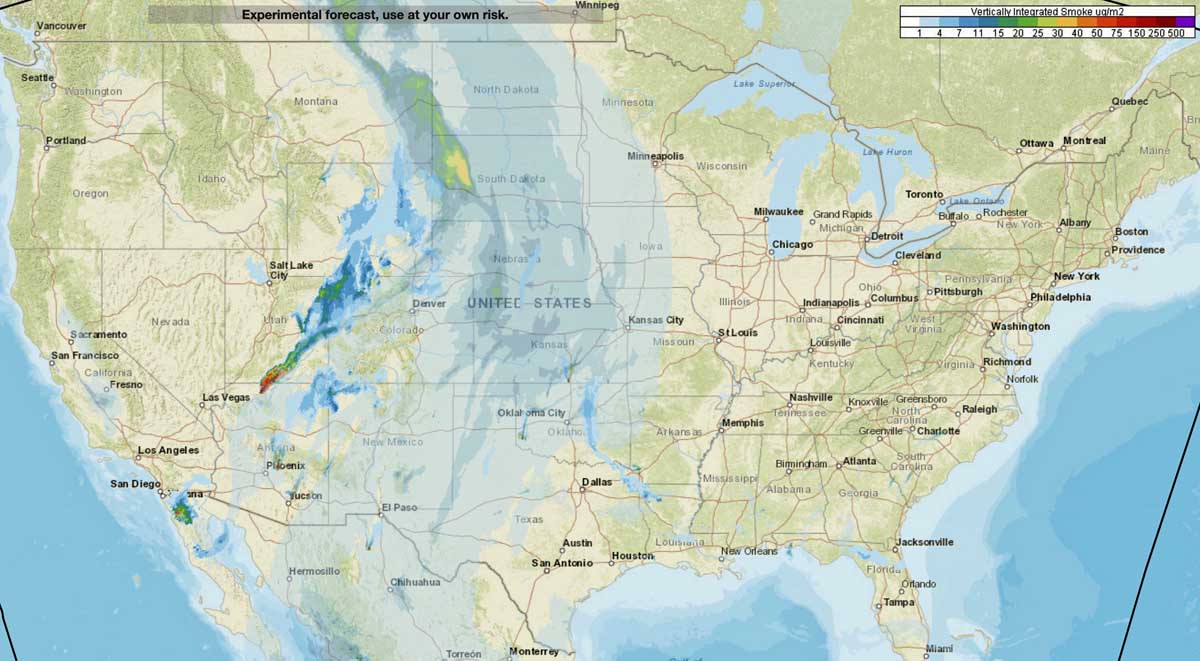
This is the forecast for near surface and vertically integrated wildfire smoke Sunday at 4 p.m. MDT June 14.
News and opinion about wildland fire
23 miles east of Yellowstone’s east entrance

The Lost Creek Fire in northwest Wyoming had burned 591 acres when a mapping aircraft overflew the fire at 2:36 Sunday morning. The blaze is on the south side of Highway 14/16/20, 23 miles west of Cody and 23 miles east of Yellowstone National Park’s east entrance. It was reported at 12:45 p.m. on Saturday.
Sunday morning the resources assigned or working on the fire included two Type 1 hand crews, multiple engines, two heavy air tankers, three single engine air tankers, two Type 1 helicopters, and one Type 3 helicopter. The Bill Cody Ranch and Rimrock Dude Ranch remain under an evacuation order.
A public meeting will be held at 5:00 p.m. Sunday at the Sheep Mountain Day Use Area of Buffalo Bill State Park. Due to ongoing health concerns, fire managers are asking the public to limit attendance to those directly impacted, and to limit the number of people per household that attend.
Restricting the number of attendees makes sense, but is certainly a change from the pre-COVID policy. It could be helpful if it were also live-streamed and available on the internet.
So far there has been no report of the highway being closed or restricting access to the east entrance of Yellowstone National Park. Here is a link to Wyoming road information.
Google Maps showed slowing of traffic on the highway at 1:02 p.m. Sunday.
The map below shows the location of the fire relative to Yellowstone and Cody.

Evacuations are in effect
(UPDATED at 6:30 p.m. MDT June 15, 2020)
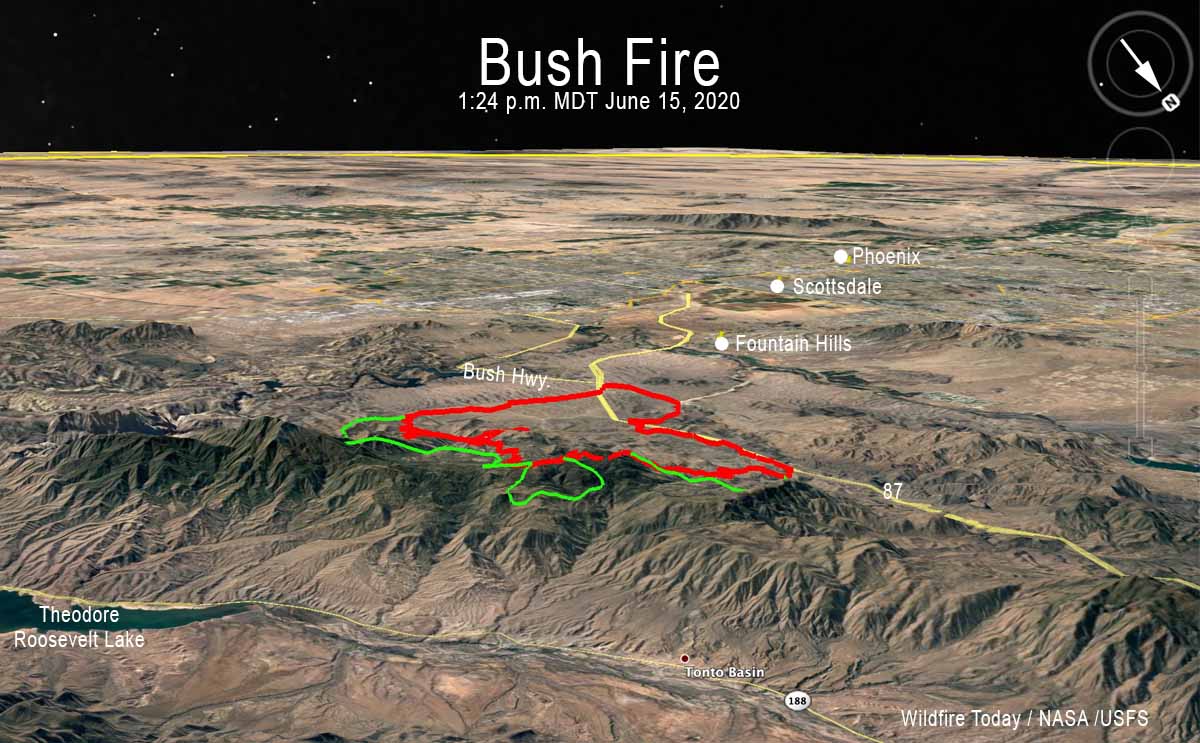
Monday afternoon the Incident Management Team on the Bush Fire announced that it had burned 37,900 acres.
For all articles on Wildfire Today about the Bush Fire northeast of Phoenix including the most recent, click here.
(UPDATED at 3:13 p.m. MDT June 15, 2020)
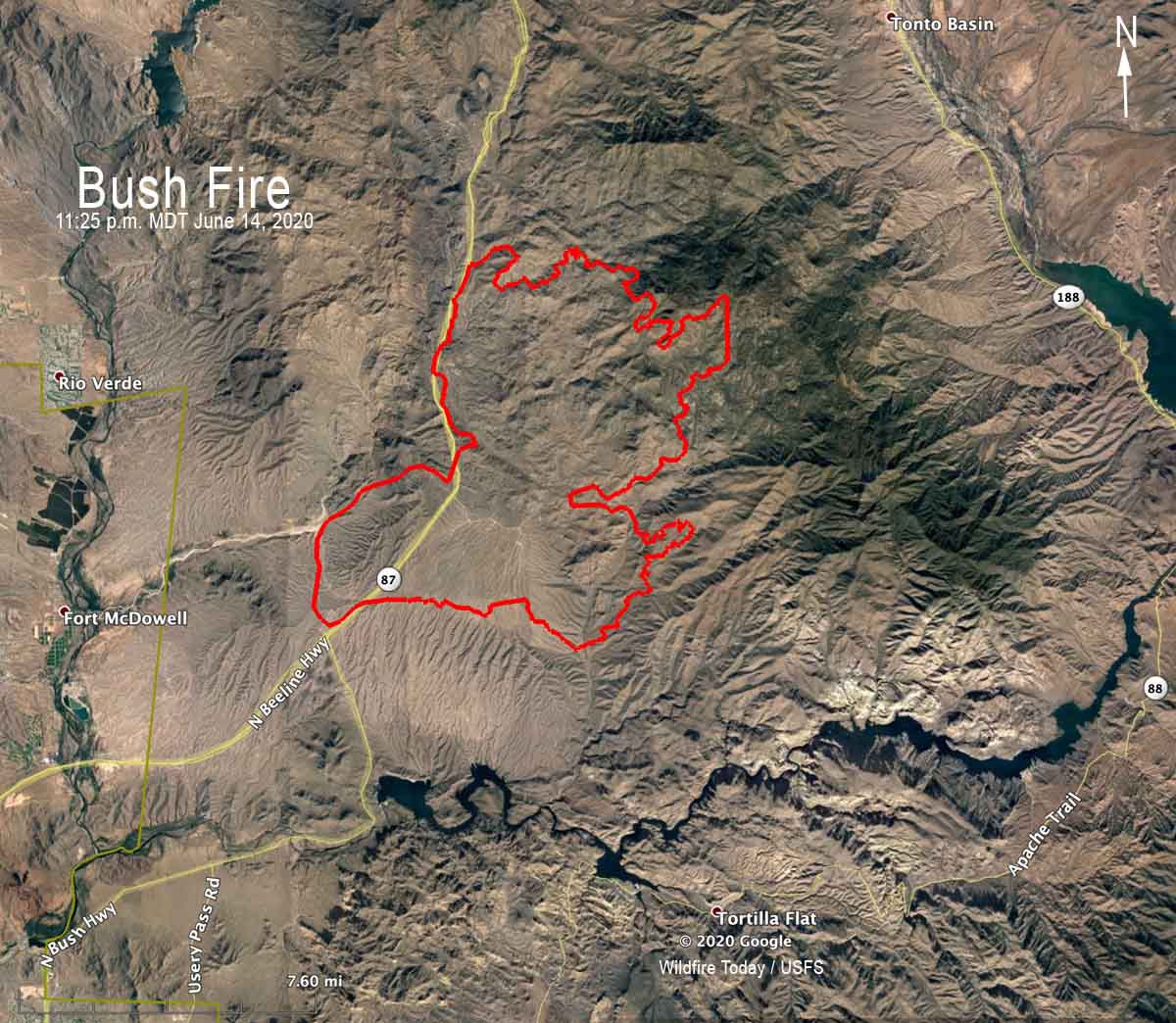
Here is a zoomed-in version of the map showing the location of the Bush Fire northeast of Phoenix at 11:25 p.m. MDT June 14, 2020. The data is from a fixed wing mapping aircraft.
For all articles on Wildfire Today about the Bush Fire northeast of Phoenix including the most recent, click here.
(UPDATED at 1:13 p.m. MDT June 15, 2020)
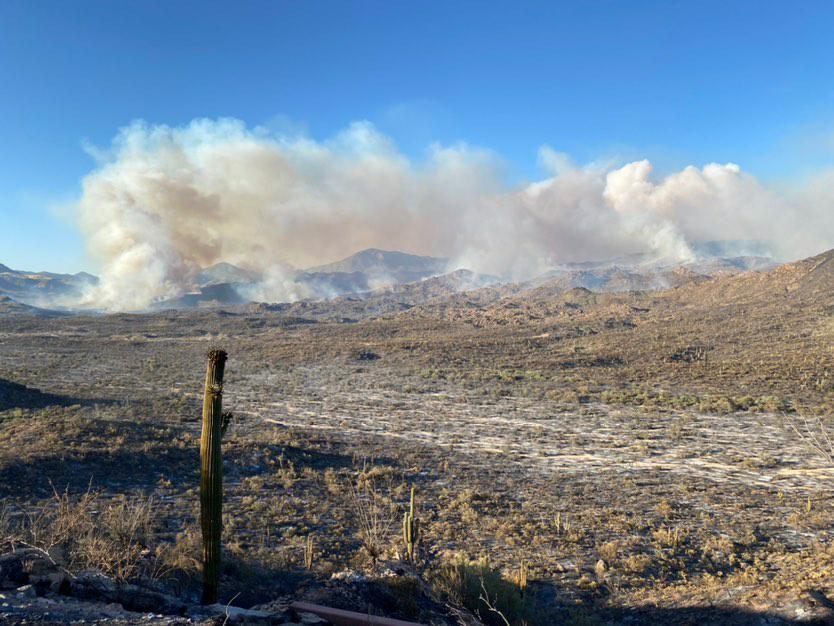
At 9:46 a.m. MST on Monday a notice from the Gila County Sheriff’s Office said, “The Tonto Basin and Punkin Center area are being evacuated. If you need to travel into the evacuated areas to remove livestock and or property you will be allowed to do so.”
A notice from the Sheriff’s office also reported, “Highway 87 from the Bush Highway M/P 199 north bound and south bound to BIA 101 entrance to the Matazal Casino in Payson is closed due to the fire on Highway 87. Only local traffic will be permitted. Residents in the local areas i.e. Rye, Gisela, Deer Creek, Ox Bow will be permitted to travel into Payson and return home. The Junction of Highway 87 and Highway 188 is closed. Highway 188 to the Roosevelt Dam is closed.”
The weather is not helping the firefighters. The forecast for the fire area on Monday is for temperatures of 81 to 91, relative humidity 12 to 17 percent, and no chance of rain. The winds will become southwesterly at 6 to 15 mph by the late morning/early afternoon. Gusts of 20-25 mph will occur over most of the mountain range, but ridgetops could see gusts nearing 30 mph. Monday night the winds will be southwest at 5 to 10 mph.
(UPDATED at 7:10 a.m. MDT June 15, 2020)
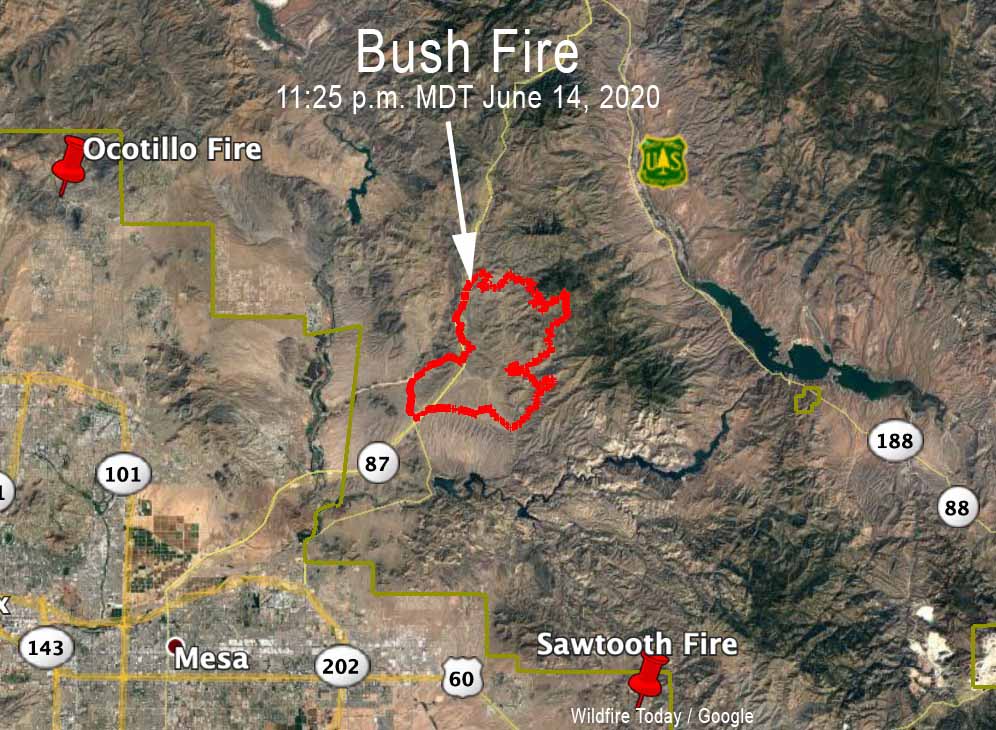
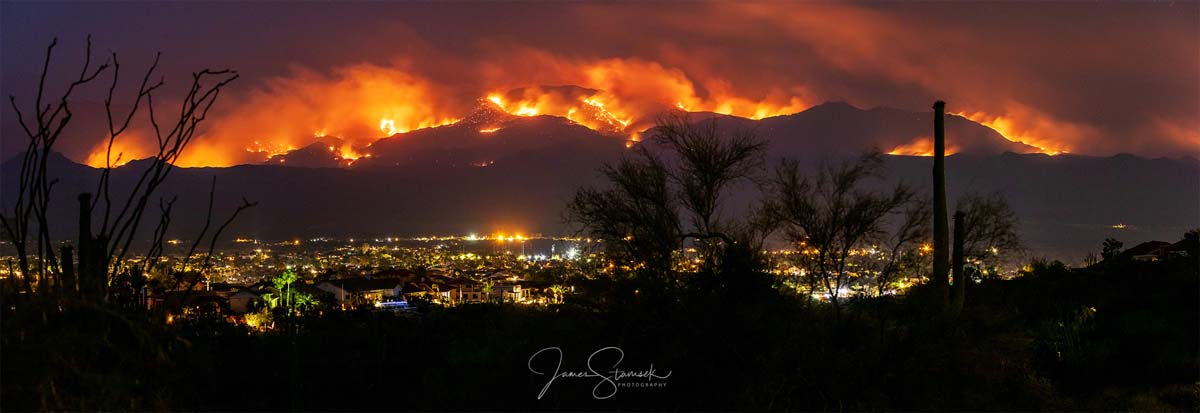
The Bush Fire was mapped at 36,257 acres Sunday night. We will post more about this fire later.
(Originally published at 9:36 a.m. MDT June 14, 2020)
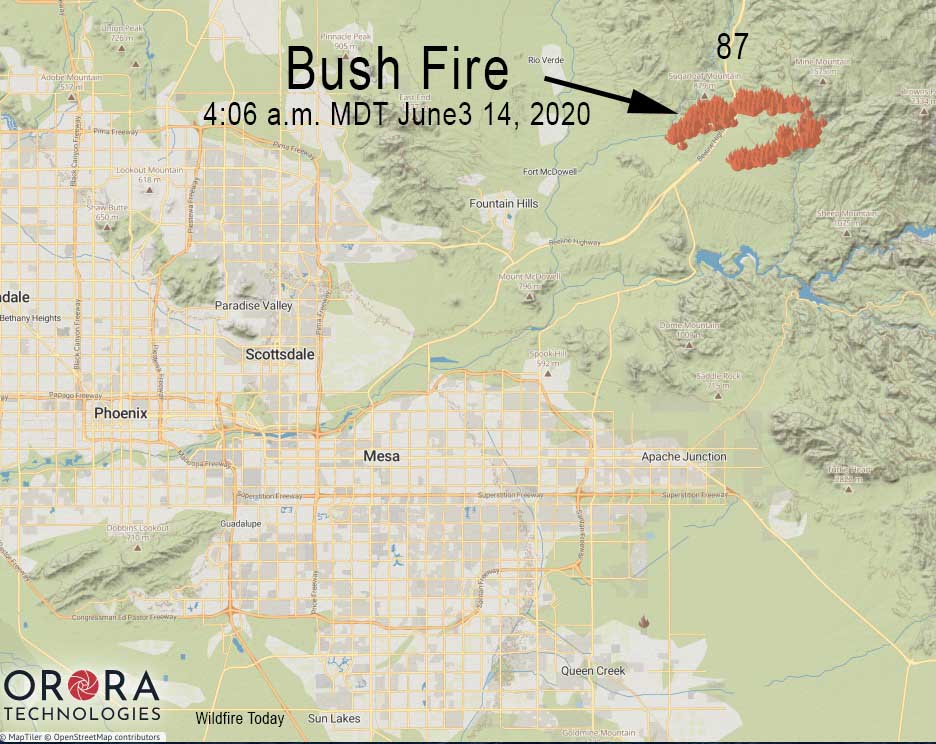
Both lanes of State Route 87 are closed northeast of Phoenix, Arizona due to a vegetation fire that was unfortunately named “Bush Fire”.
The northbound lanes are closed at Bush Highway at milepost 199, according to the Arizona Department of Transportation. The southbound highway is currently closed at State Route 188.
There is no estimated time to reopen. Drivers are encouraged to use an alternate route, such as US 60 and SR 188 through Globe, or delay travel if possible.
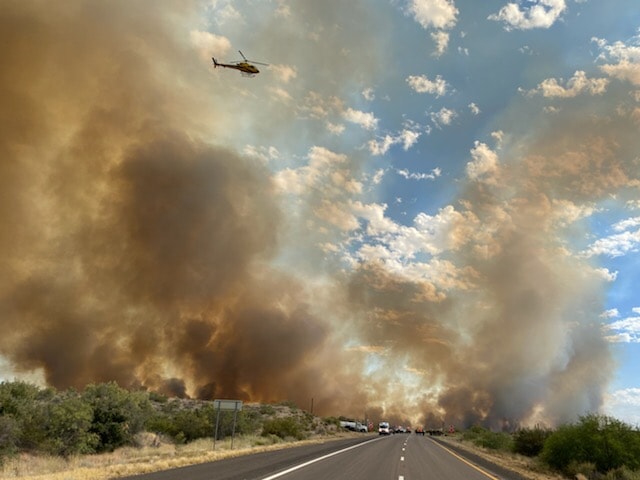
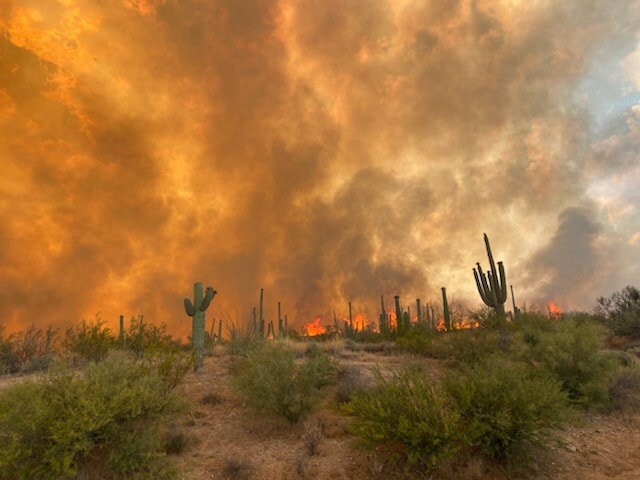
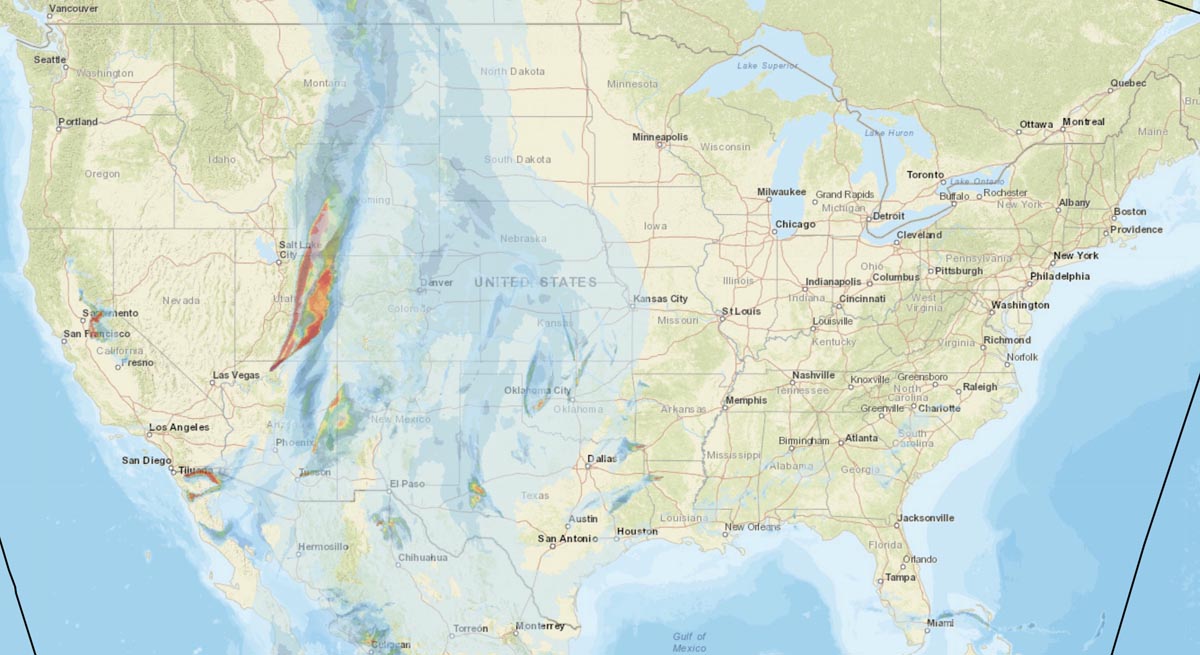
Smoke from wildfires near Tucson and north of the Grand Canyon is being pushed by strong winds into states to the north and northeast. Most heavily affected are residents in Utah, Colorado, Wyoming, and New Mexico.
The Mangum Fire near Jacob Lake, Arizona ran for 8 miles Friday and is very active again today.
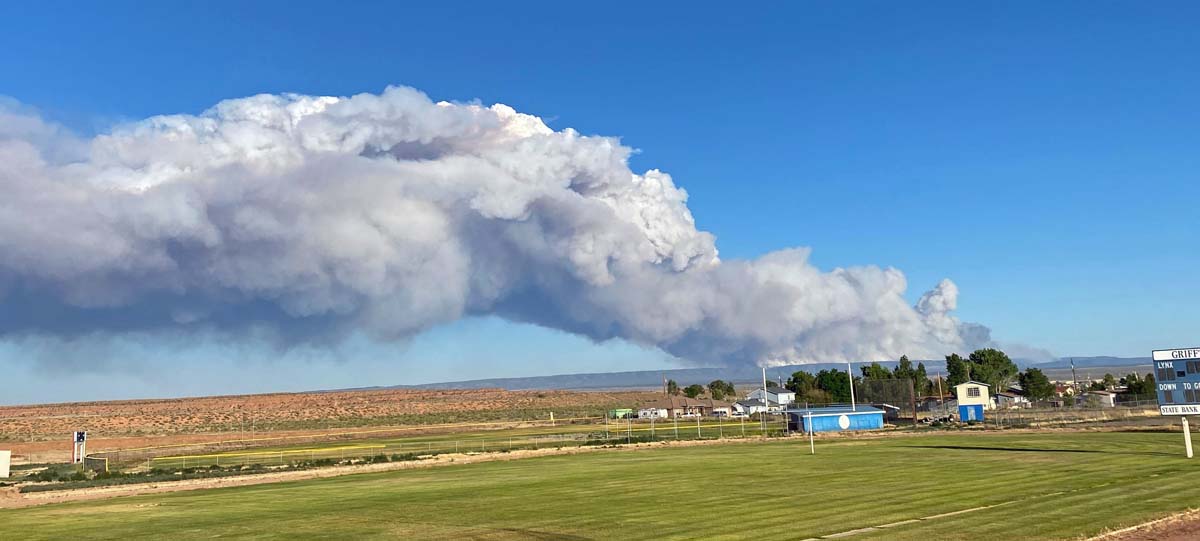
Evacuations are in effect in Jacob Lake
(UPDATED at 7:35 a.m. MDT June 14, 2020)
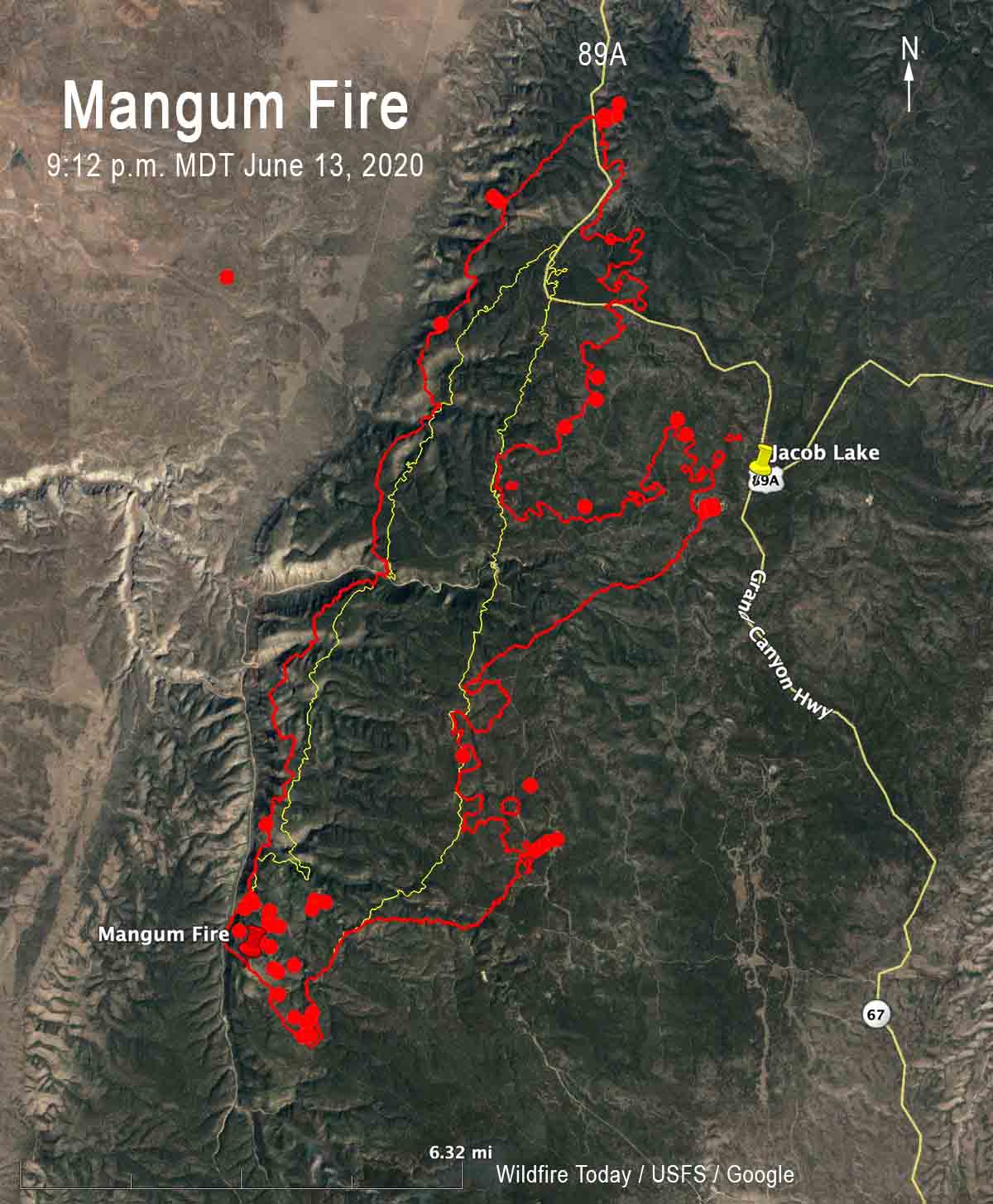
On Saturday the Mangum Fire burned very close to the small community of Jacob Lake, Arizona. During a 9:12 p.m. MDT mapping flight the fire was detected just west of the town very close to a campground and a U.S. Forest Service work center on Road 461. At that time it was less than a half mile from other facilities near the intersection of highways 89A and 67, an area with more campgrounds, an inn, and a Forest Service visitor center.
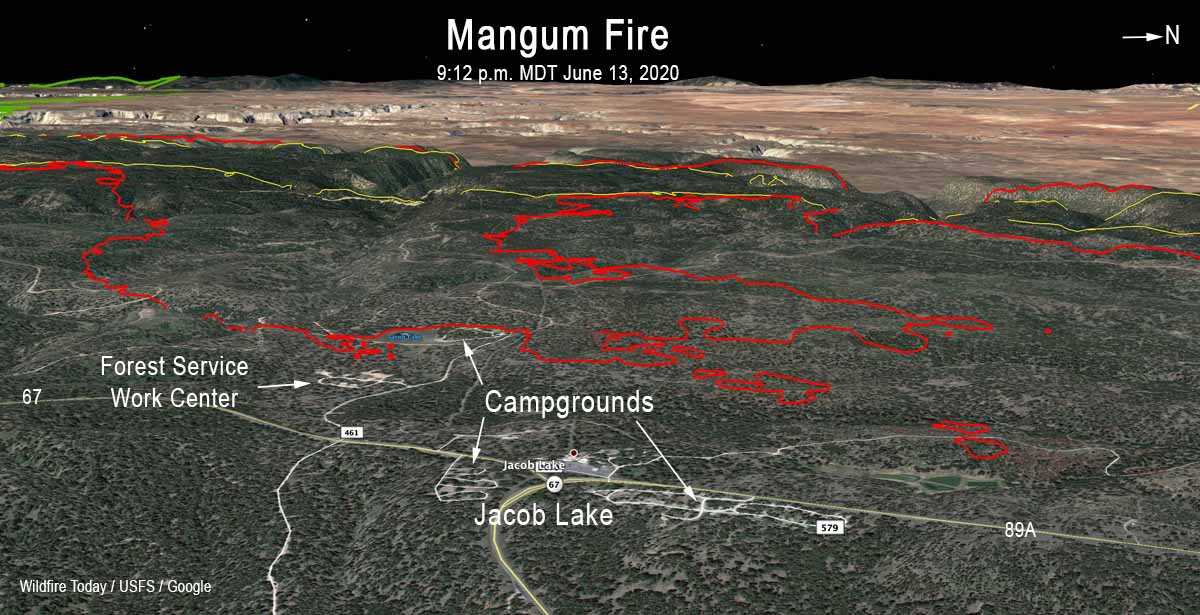
By 10 p.m. the GOES-17 satellite orbiting 22,200 miles above the Earth could no longer detect a large area of intense heat as seen in the photo below taken at 6:56 p.m. MDT Saturday. The temperature at a nearby weather station dropped to 42 degrees at 4 a.m. Sunday and overnight the wind was nearly calm after midnight. But the humidity remained low, rising from a low Saturday afternoon of 9 percent, to 29 percent by 6:47 a.m. Sunday. The fire is at high elevation, 7,000 to 8,000 feet.
The National Weather Service in Flagstaff has issued a Red Flag
Warning for the fire area Sunday due to strong winds and low relative humidity, in effect from noon to 7 p.m. MST Sunday evening. The forecast calls for a high of 79 degrees, RH of 9 percent, and 10 to 18 mph winds out of the southwest gusting at 24 to 28 mph. Similar conditions are expected for Monday. These conditions could continue to threaten Jacob Lake, which is under an evacuation order.
A Fire Weather Watch has also been issued for Tuesday due to strong winds and low relative humidity.
(UPDATED at 7:21 p.m. MDT June 13, 2020)
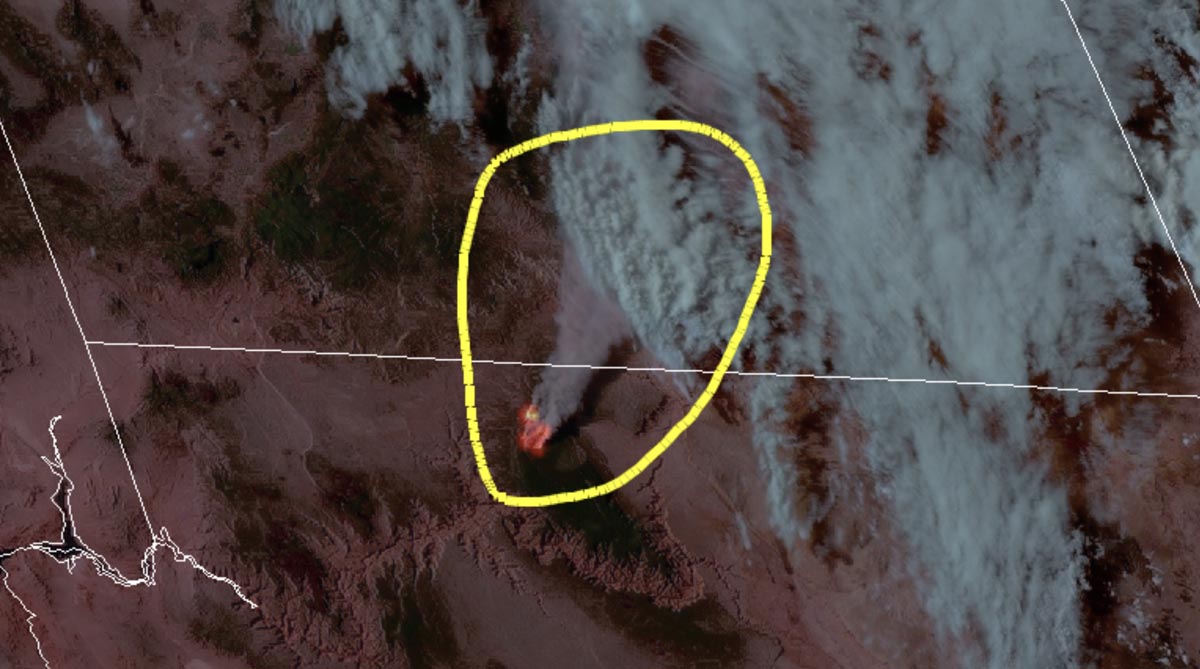
(Originally published at 4:46 p.m. MDT June 13, 2020)

Pushed by winds gusting up to 30 miles an hour, the Mangum Fire ran for an additional 8 miles to the north-northeast Friday. Creating spot fires up to one half mile ahead, it breached control lines and crossed highway 89A four miles northwest of Jacob Lake which is under evacuation orders.
For more information about evacuations contact the Coconino County Sheriff’s Office at 928-226-5089.
The fire is 18 miles southeast of Fredonia, Arizona and 12 miles north of the North Rim of the Grand Canyon.

The Mangum Fire more than quadrupled in size Friday, growing from 2,238 to 10,813 acres by 1:04 a.m. MDT June 13 when a fixed wing aircraft mapped the fire.
The area has been under Red Flag Warnings Friday and Saturday for low humidity and strong winds. On Friday the relative humidity dropped to 11 percent and the high temperature was 83 degrees at a weather station at Warm Springs Canyon. At 2:47 p.m. MST Saturday it was 71 degrees and 10 percent RH with the wind out of the south-southwest at 10 mph gusting to 25 mph.
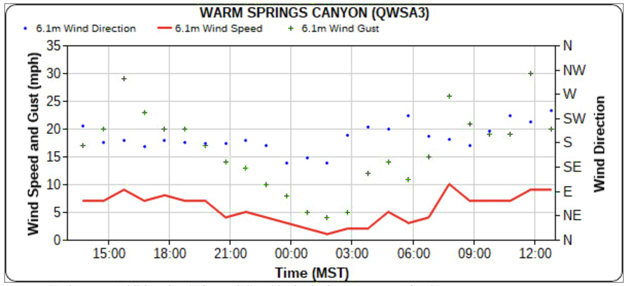
The Mangum Fire is creating a large amount of smoke that is being pushed to the north and northeast, affecting residents in Arizona, Utah, Colorado, Wyoming, and New Mexico.
The structure protection group assigned to the fire will continue working to create additional defensible space around structures and use burnouts intended to divert the blaze around the community. They are aided by a large number of fuel reduction projects around Jacob Lake that have been accomplished during the previous five years.
According to the Incident Management Team, “The fire is being managed utilizing a full suppression strategy, employing tactics that minimize impacts to important values at risk.The safety of firefighters and the public remain our number one priority.”
Saturday morning the Arizona Department of Transportation closed Highway 89A from approximately Marble Canyon to Fredonia and Highway 67 to the Grand Canyon for public safety. The U.S. Forest Service additionally has enacted a closure of the entire fire area.
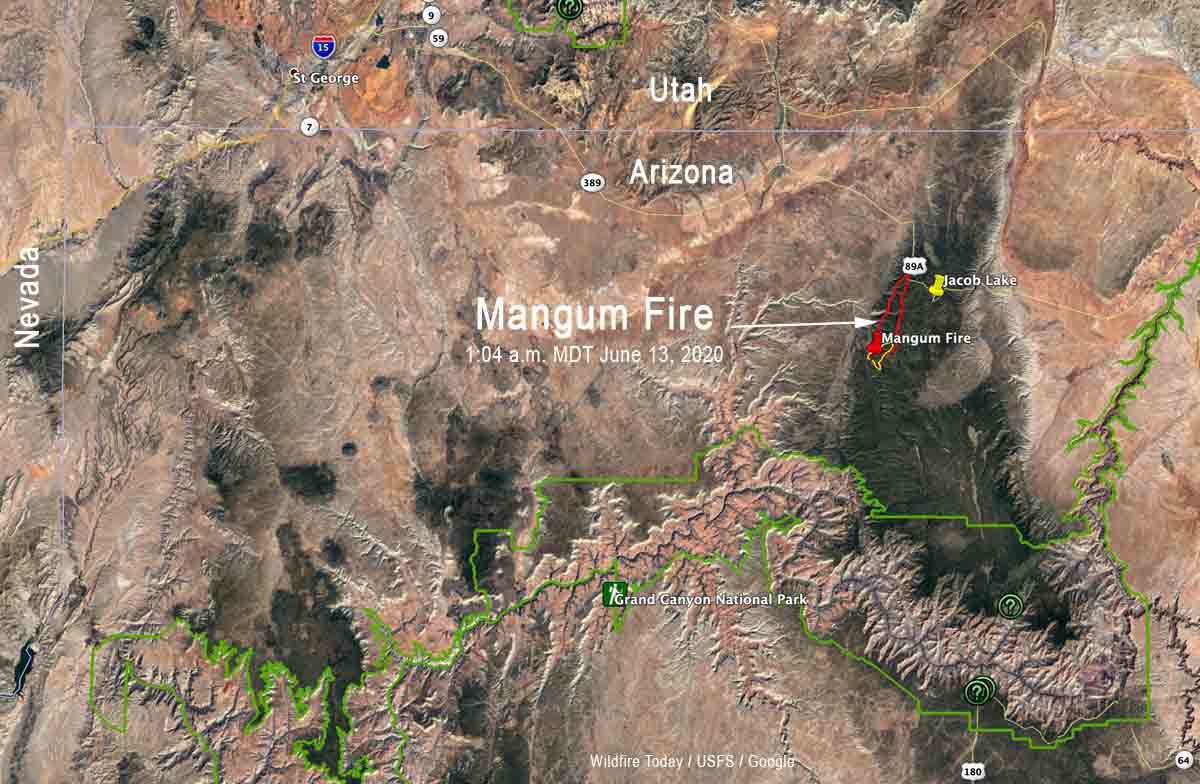

The Energy Release Component in Arizona and New Mexico is average or above for the date, but considerably higher than last year
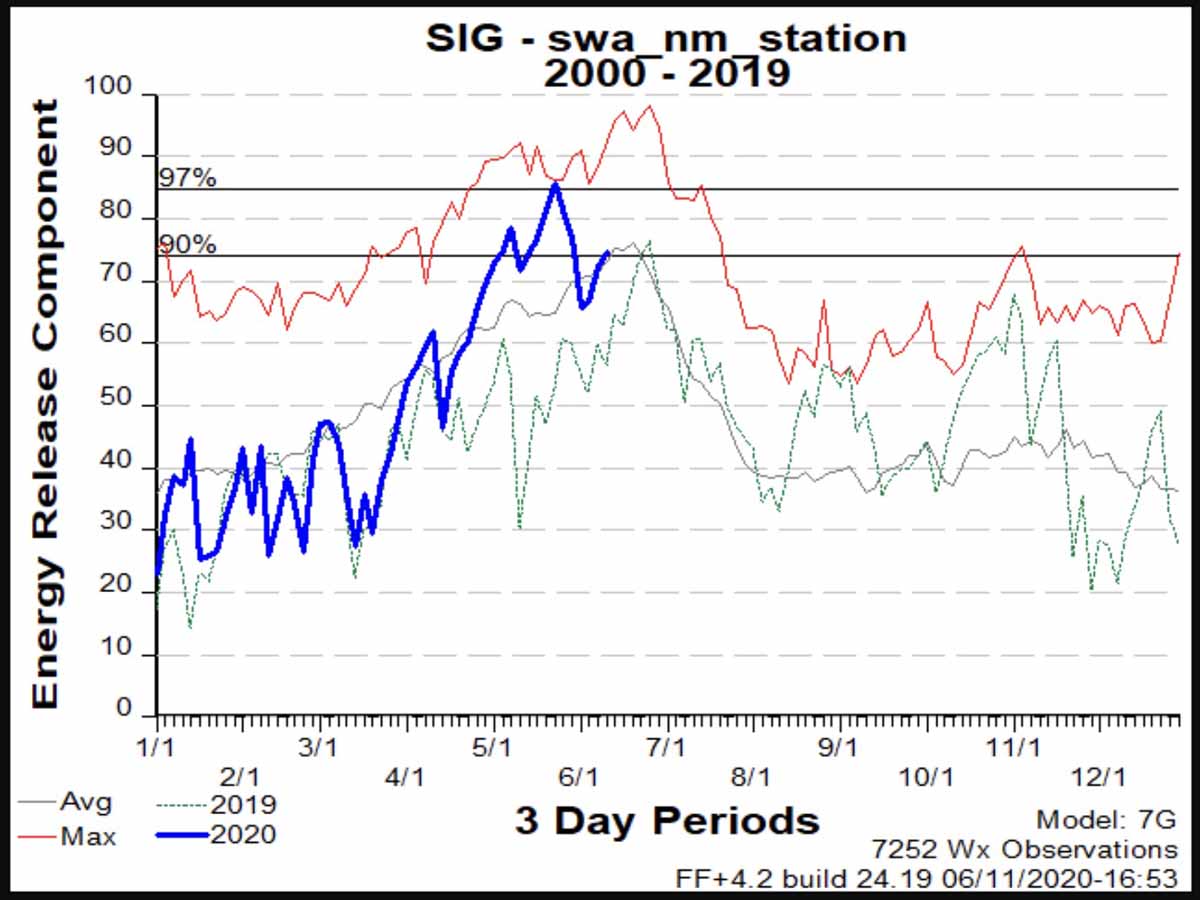
For the past two weeks most of the largest wildfires in the United States have been in Arizona, and recently the number of fires in New Mexico has also been increasing.
One of the reasons for this trend is reflected in the Energy Release Component (ERC) which is monitored from data collected at dozens of fire weather stations in the two states.
The ERC is an index indicating how hot a fire could burn. It is directly related to the 24-hour, potential worst case within the flaming front at the head of a fire.
The ERC can serve as a good characterization of a fire season since it tracks seasonal fire danger trends well. Fuel loading, woody fuel moistures, and larger fuel moistures all have an influence on the ERC, while the lighter fuels have less influence and wind speed has none. ERC has low variability, and is the best fire danger component for indicating the effects of intermediate to long-term drying on fire behavior.
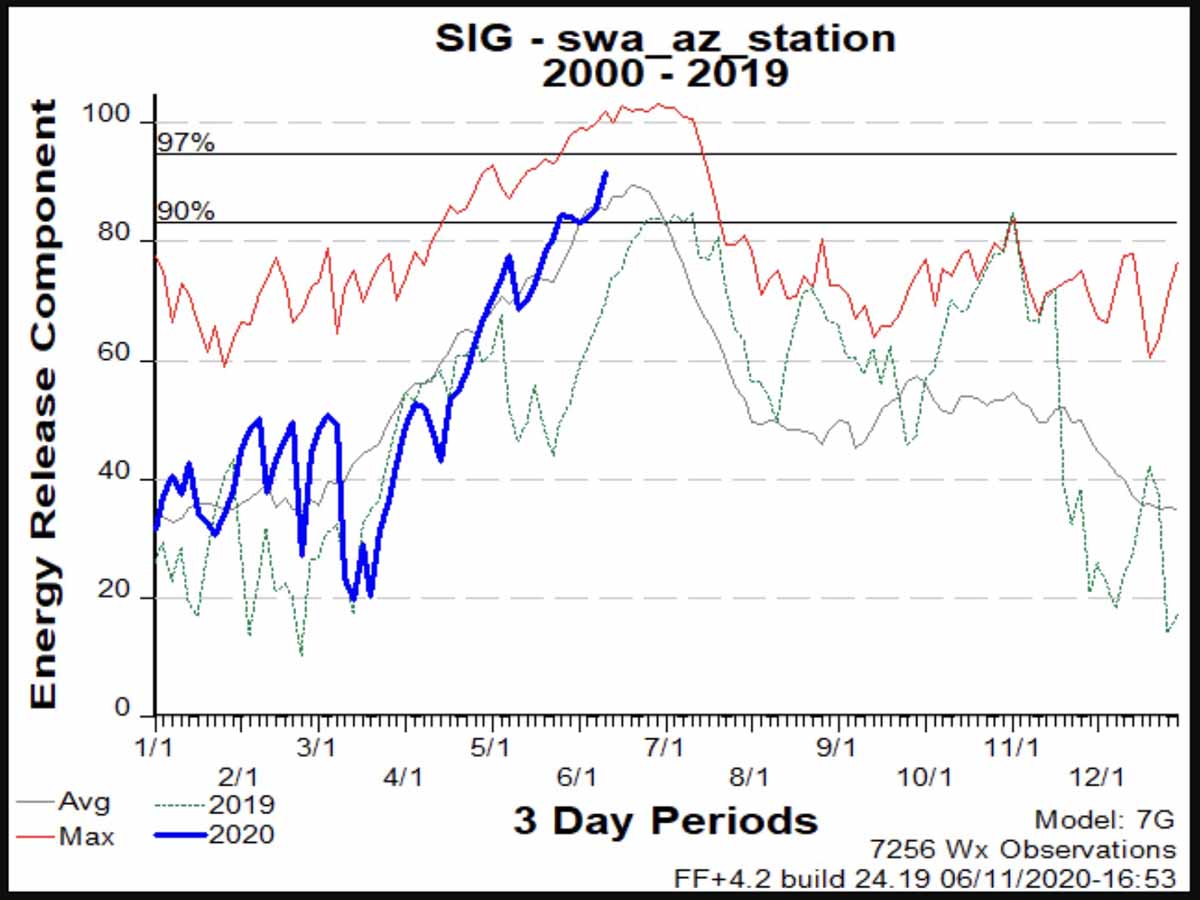
During the first six months of 2019 the statewide averages of ERC in Arizona and New Mexico were significantly below average, especially during May and June. So far during those two months this year the average ERCs have been slightly above average or well above. For the past week or so the statewide averages in the southwest have been above the 90th percentile and are nearing the 97th.
Click here to see ERC details at each of the fire weather stations in Arizona and New Mexico.
The weather forecasts for the next couple of weeks indicate that there is not much reason to think the ERCs will dip below average. WeatherUnderground predicts little or no rain in Phoenix, Flagstaff, or Albuquerque through the end of June. But the National Weather Service’s 8-14 day outlook predicts slightly higher probability of precipitation during that 7-day period, but with higher than normal temperatures.
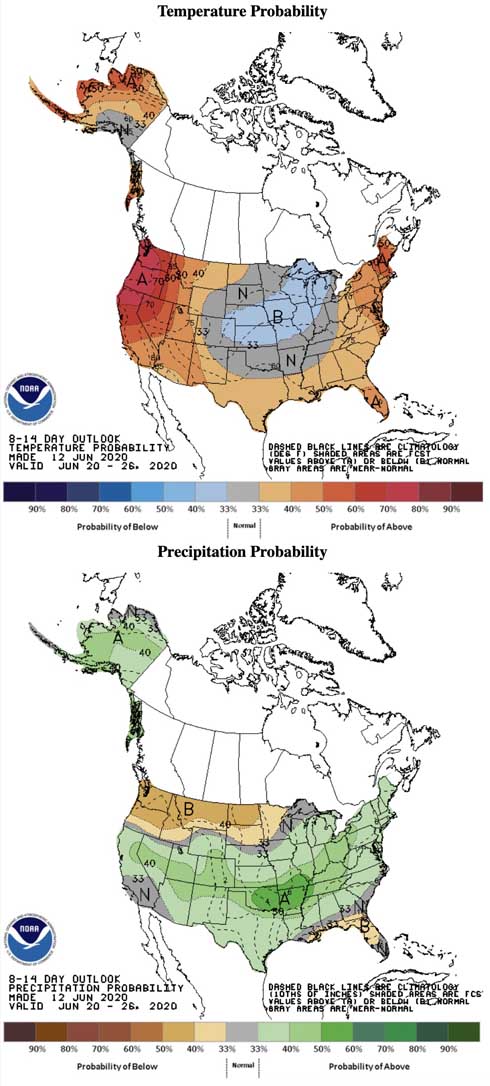
On June 1 the Predictive Services office at the National Interagency Fire Center concluded the fire potential during June and July would be higher than normal in northwest New Mexico and most of Arizona.
Below are excerpts from NIFC’s June 1 wildfire outlook in the section about Arizona and New Mexico:
“Above Normal significant large fire potential is expected across most of Arizona and northwestern New Mexico through mid-July followed by a return to Normal potential after mid-July as the monsoon arrives. Other locations across the region can expect Normal significant large fire potential.
“Over the past two months, average high temperatures have been from 1-4 degrees above Average west of the divide and generally between 2-6 degrees above average further east. Some spots in eastern New Mexico have seen high temperatures from 6-8 degrees above average. As far as precipitation, most portions of the region have seen much drier conditions over the past 60 days.
“Significant Large Fire potential is anticipated to remain Normal for many areas east of the [Continental] Divide during the month of June while most portions of Arizona into northwestern and northern New Mexico will experience Above Normal significant large fire potential. The fine fuels will be the continued focus of fire activity entering June until the larger fuels become receptive mid-month and remain so until the monsoon’s arrival in mid-July.”